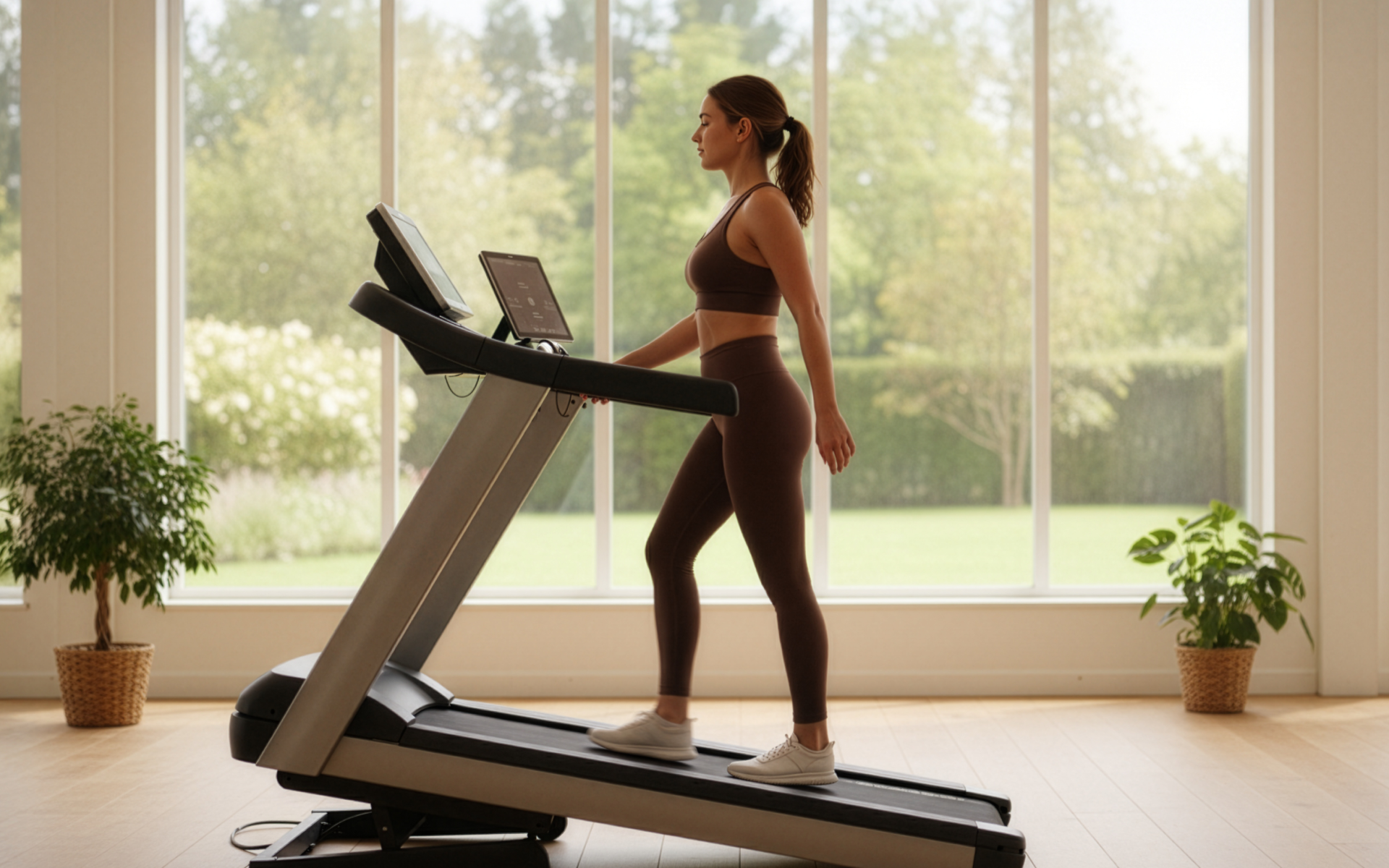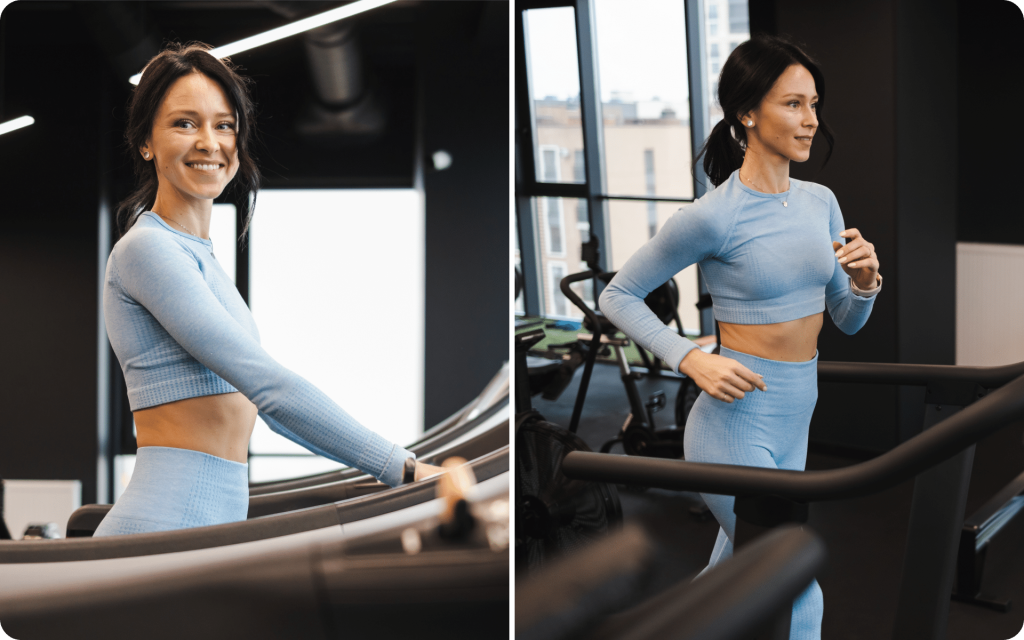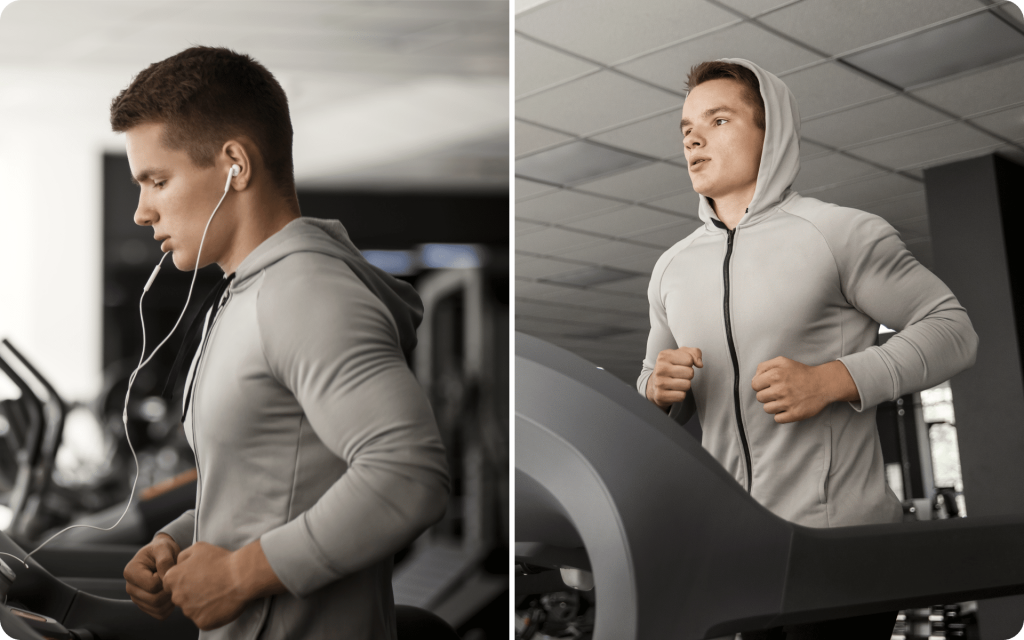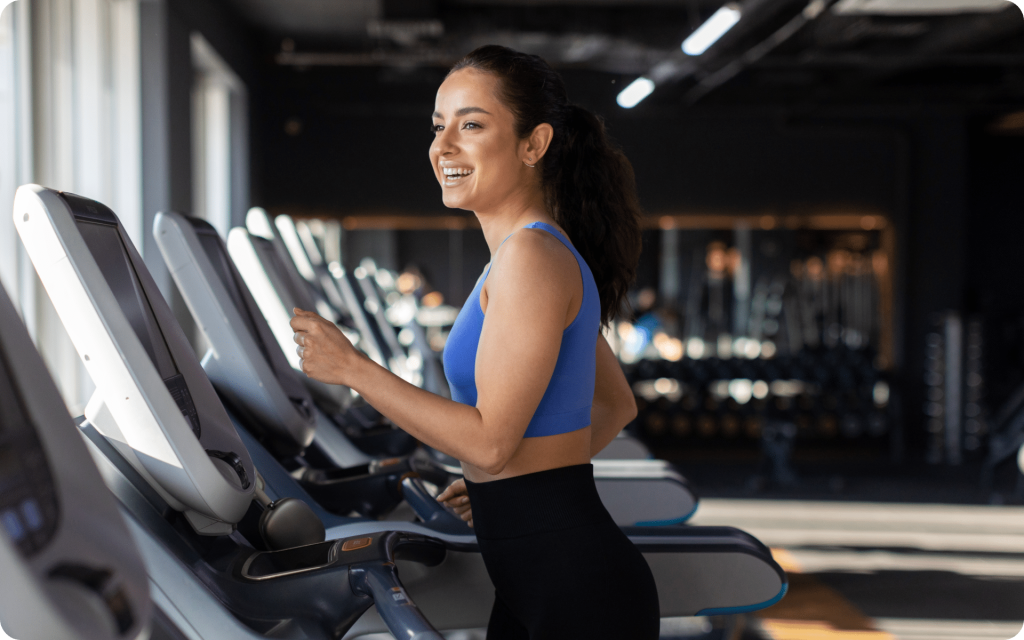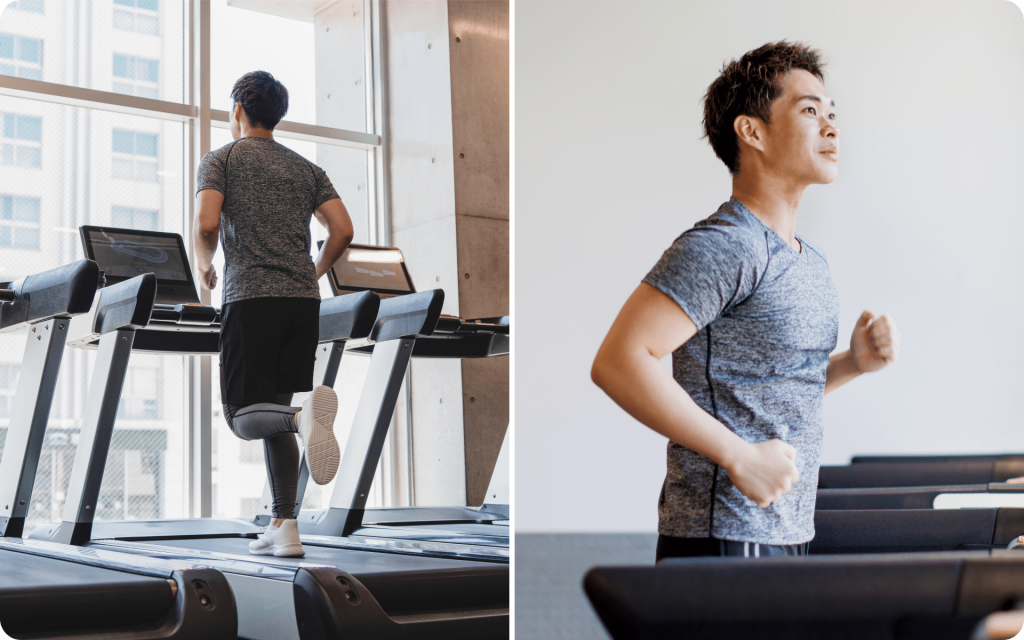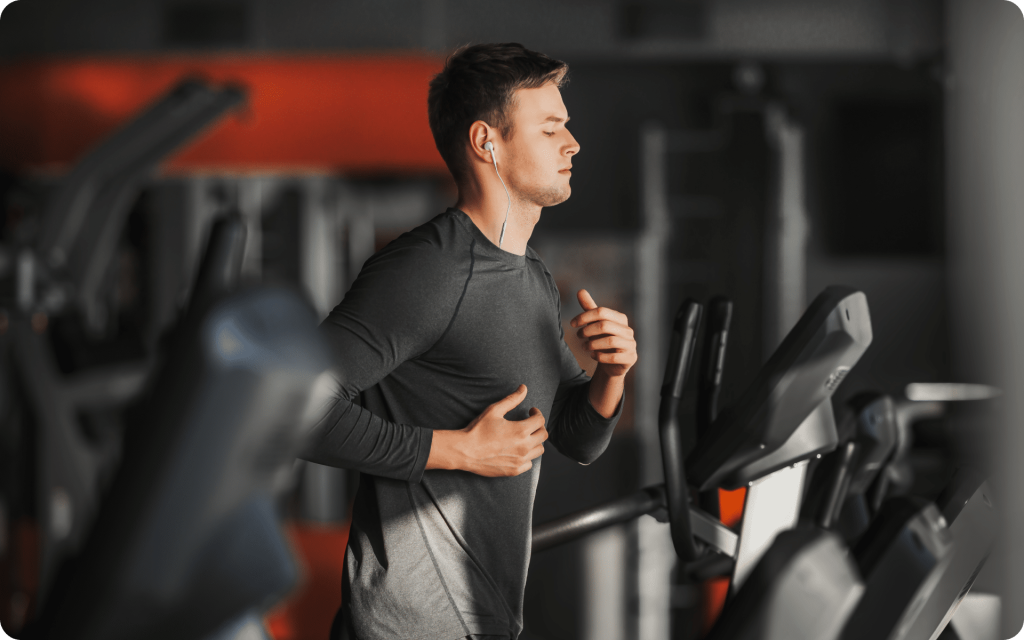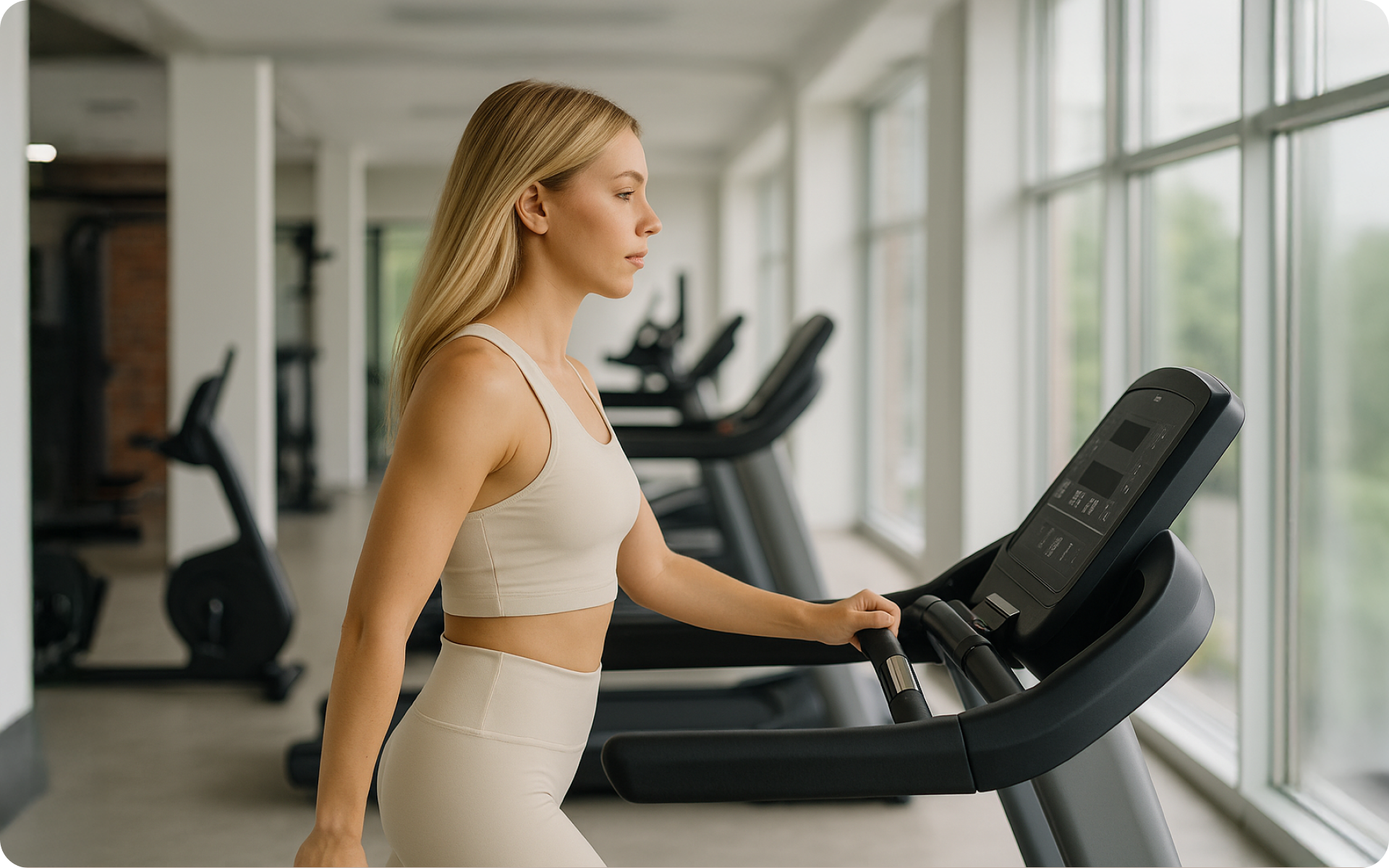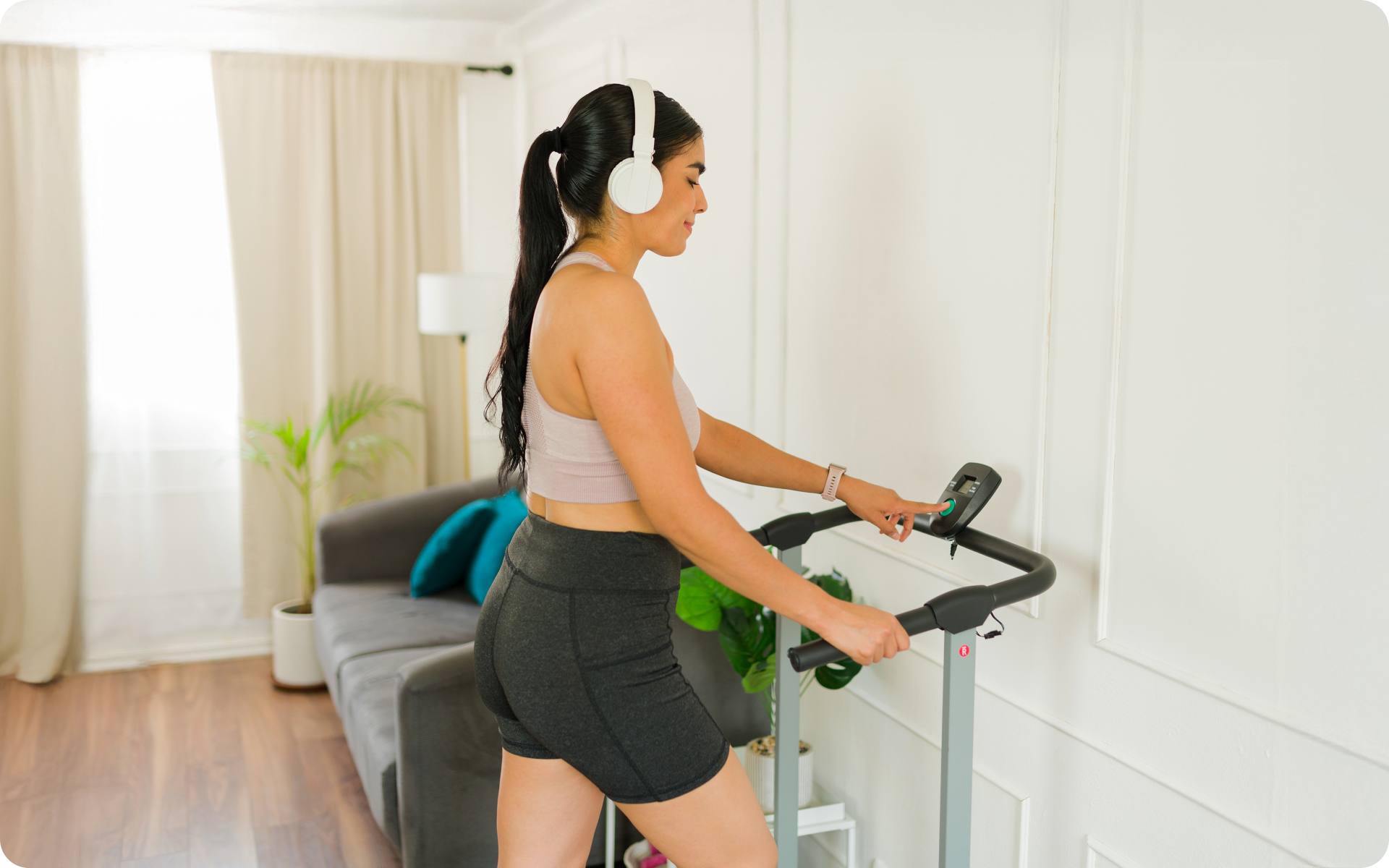The connection between incline walking and running may be closer than most people realize (1).
Both rely on powerful lower-body musculature and a well-conditioned cardiovascular system. The overlap suggests that incline walking could play a subtle but significant role in boosting your running performance.
But here’s the catch – not all training techniques work the same for everyone. Whether incline walking helps your running largely depends on factors such as how you integrate it into your routine and what aspect of your running you want to improve.
Here’s what you need to know.
Is an Incline Treadmill Good for Running?
Incline walking on a treadmill can serve as a complementary training tool for runners. It’s excellent for building strength, endurance, and cardiovascular health in ways that support your running performance.
However, it works best as part of a broader, well-rounded program. Balancing incline walking with running-specific workouts ensures you get the benefits without sacrificing the mechanics and intensity that running demands. If you’re curious about the benefits of walking on treadmill for 30 minutes, check out our earlier article.
Benefits of Incline Walking for Runners
Now let’s look at some of the reasons why you should be using incline walking in your program.
- Targeted Muscle Engagement
Incline walking shifts a higher percentage of the workload to muscles in the posterior chain, including the glutes, hamstrings, and calves. These are the same muscles that propel you forward during a run, particularly on hills or uneven terrain.
By walking on an incline, you strengthen these muscles in a controlled, low-impact manner (2). This can help build the strength that’s necessary for climbing hills or maintaining speed over long distances.
- Improved Cardiovascular Endurance
Walking on an incline increases your heart rate without the jarring impact of running. It effectively challenges your cardiovascular system, which is essential for running at higher intensities or for longer durations (3).
This low-impact alternative allows you to build endurance while minimizing the risk of overuse injuries that are associated with high-impact activities.
BetterMe: Health Coaching app helps you achieve your body goals with ease and efficiency by helping to choose proper meal plans and effective workouts. Start using our app and you will see good results in a short time.
- Joint-Friendly Conditioning
One of the standout benefits of incline walking is how gentle it is on your joints. Runners often deal with repetitive stress on their knees and ankles, which increases their risk of injury to these areas (4).
Incorporating incline walking into your routine provides a way to improve fitness and muscular endurance while allowing your joints and connective tissues some relief.
- Mental Toughness Development
Running, particularly over challenging terrain, requires mental grit (5). Walking at a steep incline can simulate the persistence that is needed to tackle uphill segments during a run, particularly when done briskly for prolonged durations.
It offers a controlled way to practice pushing through discomfort and maintaining focus, while minimizing the risk of injury.
- Varied Running-Specific Adaptations
Incline walking mimics certain aspects of hill running, such as the forward lean and the need to recruit more muscle effort per step. This can enhance your running-specific adaptations without the cumulative fatigue that running hills might bring.
Downsides of Incline Walking for Running
Incline walking can be a fantastic workout for building endurance, strengthening leg muscles, and adding variety to your cardio routine, but it’s not a perfect substitute for running. Understanding these potential downsides can help you use incline walking strategically without sabotaging your running goals.
- Lack of Specificity
Running performance hinges on specific training. While incline walking strengthens running muscles, it lacks the movement patterns and neuromuscular coordination that are required for efficient running. Adaptations from incline walking won’t transfer to running as the mechanics are different.
- Overuse Risks
While it’s low-impact, repetitive incline walking can still lead to its own set of issues and isn’t immune to overuse injuries. As you engage the knees and ankles with this exercise, excessive or improper use may increase the risk of injury in these areas (6).
Ensuring a well-balanced routine is key to avoiding imbalances or injury.
- Reduced Training Intensity for Advanced Runners
While elite or highly experienced runners can use incline walking for recovery, they may find that incline walking does not adequately challenge their fitness levels compared to speed intervals or threshold runs.
For those who are aiming to improve race performance, this method may not provide the necessary stimulus to create meaningful adaptations.
- Potential for Over-Reliance
Relying too heavily on incline walking at the expense of actual running could limit your development as an efficient and adaptable runner. To improve running economy and pacing strategies, time spent on varied running distances and speeds is essential.
Read more: Incline Walking vs Running for Fat Loss: Which Is Better?
Does Incline Walking Increase Stamina?
Stamina refers to your ability to sustain physical or mental effort over time (7). For athletes, this often means enduring longer periods of exercise without fatigue.
Incline walking has the potential to improve your stamina by improving cardiovascular endurance, muscular endurance, and your ability to sustain effort through aerobic energy engagement.
Cardiovascular Improvements
Incline walking challenges your heart and lungs by increasing the intensity of a typically low-impact activity. Walking at a steep incline raises your heart rate significantly more than walking on flat ground, which stimulates your cardiovascular system (3). This helps improve your body’s ability to deliver oxygen to working muscles, which is a key aspect of building stamina.
In addition, newer runners can usually walk briskly on an incline longer than they can run. This gives them the ability to perform prolonged exercise at a higher intensity than just walking.
Over time, consistent incline walking can boost your aerobic capacity, which means you can sustain higher effort for longer periods.
Muscular Endurance Development
Walking uphill requires sustained engagement of key muscle groups, including the calves, hamstrings, glutes, and quadriceps. Repeating this motion strengthens these muscles and improves their ability to endure prolonged activity (2).
This muscular endurance is particularly beneficial for activities such as trail running or hill climbing, where the stamina to repeatedly push against gravity is essential. For more details about treadmill workouts to increase speed and endurance, take a look at our prior publication.
Multiple Energy Systems Engagement
Incline walking primarily engages the aerobic energy system, which relies on oxygen to supply energy for prolonged, steady-state activities.
If you include intervals with steeper inclines or faster paces, you can also tap into your anaerobic energy system. This system supports short bursts of high-intensity effort and complements your endurance training by improving your body’s ability to tolerate and recover from exertion.
Potential Limitations
While incline walking has clear benefits, it does have its limitations. It may not offer the same intensity as running or other high-energy exercises. This could limit its effectiveness if you’re already highly conditioned or need more demanding training stimuli to improve.
In addition, as incline walking doesn’t replicate the exact biomechanics of running or other sports, gains in stamina may not directly translate to those activities.
How Much Does Incline Affect Running?
An incline influences various aspects of running, from how your body moves to how much energy you use.
1. Running Mechanics
- Shorter Strides: Running uphill naturally shortens your stride. This reduces the stress on joints, but increases the workload on your muscles per step (8).
- Forward Lean: You instinctively lean slightly forward, which results in faster acceleration (9).
- Drive Through Muscles: Your legs have to drive harder to push against gravity and lift your body, leading to greater force generation with each step and enhancing endurance (10).
2. Muscle Engagement
- Glutes and Hamstrings: Uphill running intensifies the activation of your glutes and hamstrings, as they play a primary role in propelling you upward (11).
- Calves and Achilles Tendon: Steeper inclines force your calves and Achilles tendons to work harder (12), which can be beneficial, but also increases injury risk if overtrained.
- Core Activation: Some studies have suggested that posture stability demands change when running uphill, which may implicate greater core involvement (although direct evidence of increased core EMG is limited) (13, 14).
BetterMe will shake off your mental funk, rid you of your energy-zapping habits, and help you sculpt the body of your dreams. Intrigued? Hurry up and change your life for the better!
3. Energy Expenditure
- Higher Calorie Burn: Running on an incline increases energy demands (15). This translates to more calories burned compared to flat ground running at the same pace.
- Greater Oxygen Use: Climbing requires more oxygen, which adds to the cardiovascular workload and overall effort (16).
- Fatigue Factor: Sustaining an incline is more fatiguing, so your endurance may be tested during prolonged uphill efforts.
4. Cardiovascular Demand
- Heart Rate Increase: Running uphill causes your heart rate to spike faster than on flat terrain, which makes it excellent for building cardiovascular capacity (16).
- Improved VO2 Max: Repeated exposure to incline running can improve your VO2 max (your body’s ability to use oxygen effectively), which is essential for endurance sports (16).
- Recovery Benefits: Practicing inclines moderately can prepare your heart and lungs for the demands of steep hill races or tougher training runs (17).
Benefits of Incline Running:
- Builds strength in key running muscles, which helps with hill running and overall power.
- Improves cardiovascular fitness for both endurance and short bursts of effort.
- Simulates race conditions if your course includes hills.
Challenges of Incline Running:
- Increased risk of overuse injuries, particularly in the calves and Achilles tendons (18).
- Heavier energy demand, which can be fatiguing if it’s not introduced gradually.
- Less focus on running economy, as mechanics change compared to flat-ground running.
What Incline Walking Workout Helps Improve Running?
If you’re looking to use incline walking as a tool to improve your running performance, a structured routine can help you get the most out of it.
Mobility Warm-Up (5-10 minutes)
Before you step on the treadmill, it’s essential to prepare your body for movement. This helps loosen up stiff muscles and improve joint mobility, which is crucial for a safe and effective workout (18).
- Dynamic Hamstring Stretch (Leg Swings):
- Stand tall and swing one leg forward and back, keeping it straight.
- Perform 10-12 swings per leg to activate your hamstrings.
- Walking Lunges with a Twist:
- Take a long step forward into a lunge position.
- Twist your torso gently toward the leading leg, then return to standing.
- Repeat for 8–10 lunges on each side, warming up your hips and core.
- Ankle Circles:
- Stand on one leg and lift the other slightly off the ground.
- Rotate the raised ankle in slow circles, 10 times clockwise and 10 times counterclockwise per foot.
- This primes your ankles and calves for incline walking.
- High Knees:
- March in place, bringing your knees up toward your chest.
- Pump your arms and pick up the pace for 30-60 seconds to activate your hip flexors and increase your heart rate.
Incline Walking Workout (30-40 minutes)
This incline walking routine includes varying gradients and speeds to mimic hill running and build running-relevant strength and endurance. Adjust the intensity as required to match your fitness level.
Phase 1: Warm-Up Walk (5 minutes)
- Incline: 0%-2%.
- Speed: 3.0-4.0 mph (moderate pace).
- Focus on light, even steps to gradually raise your heart rate.
Phase 2: Steady Incline Walking (10 minutes)
- Incline: 5%-6%.
- Speed: 3.5-4.5 mph (challenging but sustainable pace).
- Maintain an upright posture and engage your core throughout the climb.
Phase 3: Incline Intervals (15 minutes)
Alternate between higher inclines and recovery periods to simulate the effort and recovery needed for hill running.
- Work Interval (2 minutes):
- Incline: 8%-10%.
- Speed: 3.5-4.0 mph (brisk pace).
- Recovery Interval (2 minutes):
- Incline: 4%-5%.
- Speed: 3.0-3.5 mph (slower pace).
- Repeat this cycle 4-5 times.
Phase 4: Gentle Hill Walk (5 minutes)
- Incline: 3%-4%.
- Speed: 3.0-3.5 mph.
- Gradually bring your heart rate down while still engaging your muscles.
Our previous post goes into great detail about the treadmill interval workout.
Cool-Down and Stretch (5-10 minutes)
After the workout, it’s vital to help your body recover by lowering your heart rate and stretching the muscles you worked (19).
- Slow Flat Walk (3 minutes):
- Walk on a 0% incline at an easy pace (2.5-3.0 mph).
- Focus on deep, steady breathing to bring your heart rate back to baseline.
- Calf Stretch:
- Stand facing a wall or sturdy surface. Place one foot back and press your heel into the floor while keeping your back leg straight.
- Hold for 20-30 seconds per leg to stretch your calves and Achilles tendons.
- Hip Flexor Stretch:
- Step one foot forward into a lunge, with your back knee resting on the ground.
- Tuck your pelvis slightly forward to feel a stretch along the front of your rear thigh.
- Hold for 20-30 seconds per side.
- Hamstring Stretch:
- Sit on the floor with one leg extended straight and the other bent so the sole of your foot rests against your inner thigh.
- Hinge forward gently from your hips to stretch the back of your extended leg.
- Hold for 20-30 seconds per leg.
- Standing Quad Stretch:
- Stand on one leg while holding the opposite ankle and pulling it gently toward your glutes.
- Keep your knees close together and your chest upright.
- Hold for 20-30 seconds per side.
Is 30 Minutes of Incline Walking Enough for an Active Lifestyle?
30 minutes of walking at a moderate effort (approximately 50%-75% of your maximum heart rate) is enough for most people. This duration is aligned with recommendations for aerobic activity set by fitness authorities, which suggest aiming for at least 150 minutes of moderate-intensity cardio per week (20).
If weight loss is your goal, 30 minutes of incline walking can make a noticeable difference, particularly when paired with a well-balanced diet.
If building strength and endurance is your goal, 30 minutes may be enough for beginners to see improvement. Adjusting incline and speed for comfort is important at this stage, so make sure to add intensity and duration slowly as you progress.
Yes, running on an incline is harder as it requires more effort to propel your body upward against gravity. It increases your heart rate, energy expenditure, and activates muscles such as the glutes, hamstrings, and calves more intensely compared to flat running. Bodybuilders use incline walking as a low-impact way to burn fat while preserving muscle mass. They rely on the higher intensity of incline walking vs flat walking for this outcome. It also strengthens the lower-body muscles and improves cardiovascular fitness without the strain high-intensity workouts can place on their bodies during recovery periods. Yes, running burns fat by increasing your overall calorie expenditure. If you’re in a calorie deficit, it utilizes stored fat as an energy source, particularly during longer or moderate-intensity runs (21), which makes it an effective exercise for fat loss when combined with a calorie-controlled diet. Yes, it’s safe to run on an incline as long as you start with a manageable gradient and increase it gradually to avoid overexertion or injury. Running on an incline can improve strength, endurance, and calorie burn, but proper form is crucial for preventing strain, particularly on the knees and lower back.Frequently Asked Questions
Does an incline make running harder?
Why do bodybuilders do incline walking?
Does running burn fat?
Is it OK to run on an incline?
The Bottom Line
Incline walking is a tool that can significantly enhance your running performance. By incorporating it into your training routine, you can build endurance, strengthen key muscles such as your glutes and calves, and increase calorie burn. However, it’s essential to approach incline walking with caution and gradually increase the gradient to avoid injury.
DISCLAIMER:
This article is intended for general informational purposes only and does not serve to address individual circumstances. It is not a substitute for professional advice or help and should not be relied on for making any kind of decision-making. Any action taken as a direct or indirect result of the information in this article is entirely at your own risk and is your sole responsibility.
BetterMe, its content staff, and its medical advisors accept no responsibility for inaccuracies, errors, misstatements, inconsistencies, or omissions and specifically disclaim any liability, loss or risk, personal, professional or otherwise, which may be incurred as a consequence, directly or indirectly, of the use and/or application of any content.
You should always seek the advice of your physician or other qualified health provider with any questions you may have regarding a medical condition or your specific situation. Never disregard professional medical advice or delay seeking it because of BetterMe content. If you suspect or think you may have a medical emergency, call your doctor.
SOURCES:
- Steep (30°) uphill walking vs. running: COM movements, stride kinematics, and leg muscle excitations (2020, pubmed.ncbi.nlm.nih.gov)
- THE FUNCTIONAL ROLES OF MUSCLES DURING SLOPED WALKING (2016, ncbi.nlm.nih.gov)
- Assessment of Exercise Intensity for Uphill Walking in Healthy Adults Performed Indoors and Outdoors (2022, ncbi.nlm.nih.gov)
- A systematic review of running-related musculoskeletal injuries in runners (2021, sciencedirect.com)
- Mental Toughness and Resilience in Trail Runner’s Performance (2023, ncbi.nlm.nih.gov)
- Lower limb joint angles and their variability during uphill walking (2021, sciencedirect.com)
- What Does Mental Stamina Mean? (n.d., medicinenet.com)
- Biomechanics and Physiology of Uphill and Downhill Running (2016, link.springer.com)
- Transition from upright to greater forward lean posture predicts faster acceleration during the run-to-sprint transition (2023, sciencedirect.com)
- The effects of uphill training on the maximal velocity and performance of middle-distance runners: a randomized controlled trial (2025, nature.com)
- Sprint Acceleration Mechanics: The Major Role of Hamstrings in Horizontal Force Production (2015, frontiersin.org)
- The Effects of Grade and Speed on Leg Muscle Activations during Walking (2011, pmc.ncbi.nlm.nih.gov)
- Change in trunk muscle activity during incline treadmill running (2011, commons.nmu.edu)
- Muscle synergies are consistent across level and uphill treadmill running (2018, nature.com)
- A review of uphill and downhill running: biomechanics, physiology and modulating factors (2025, frontiersin.org)
- Effect of Uphill Running on VO2, Heart Rate and Lactate Accumulation on Lower Body Positive Pressure Treadmills (2021, pmc.ncbi.nlm.nih.gov)
- The Effects of Incline and Level-Grade High-Intensity Interval Treadmill Training on Running Economy and Muscle Power in Well-Trained Distance Runners (2014, journals.lww.com)
- Influence of running speed, inclination, and fatigue on calcaneus angle in female runners (2025, frontiersin.org)
- Warm Up, Cool Down (2024, heart.org)
- Adult Activity: An Overview | Physical Activity Basics (2023, cdc.gov)
- The Regulation of Fat Metabolism during Aerobic Exercise (2020, ncbi.nlm.nih.gov)
